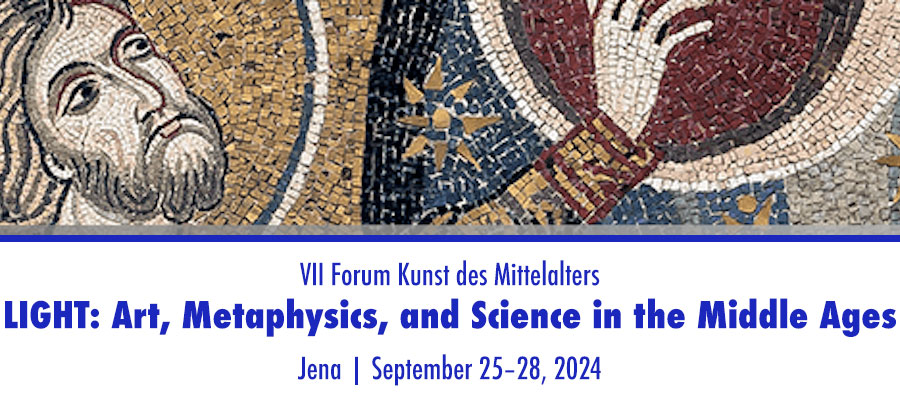Light: Art, Metaphysics, and Science in the Middle Ages, 7th Forum Kunst des Mittelalters, Jena, September 25–28, 2024
In numerous creation myths, light stands at the beginning of the cosmos. In the Middle Ages, the concepts of light, beauty, and the good were inseparable. Darkness, ugliness, and the evil formed the opposite pole. The degree of perfection of nature, people, and artifacts could be measured by their beauty, which was essentially determined by brightness, brilliance, and luminosity. This concept applied to Byzantium as well as to the Christian West, Judaism, and Islam. To communicate this idea and to enable its experience was not only the highest goal of religious art in the Middle Ages, but also shaped secular and courtly culture. Centering around the topic of light, the 7th “Forum Kunst des Mittelalters” (Jena, September 25–28, 2024) will focus on the multifaceted connections between art, metaphysics, and science in the Middle Ages.
By emphasizing the light-related properties of materials (transparency, reflectivity), medieval artists imbued their creations with an aesthetic quality that pointed beyond the beautiful to the divine as the origin of all things. Questions about the relationship between luminous or light-reflecting materials (gold, silver, gemstones, alabaster, bronze, ivory, silk) and objects, as well as the connection between material, light, and aura were of highest significance across cultures and genres. Rock crystal objects between East and West have recently been the focus of several exhibitions and scholarly studies. Glass as a translucent material par excellence also raises transcultural questions, ranging from the significance of the material as a substitute for gemstones to the realm of its allegorical readings and its function in making the sacred visible.
In architecture, the topic of artists working with and manipulating light can be addressed with reference to cathedrals, castles, and palaces as well as mosques, madrasas, and synagogues. Possible fields of investigation are the relationship between light and built space, the role of light in the design of facades, wall openings, and windows, or the function of dark, windowless spaces in the staging of the sacred.
Luminiferous objects such as candles, chandeliers, and other sorts of lamps served to mark meaningful places or to stage prominent persons and ritual actions, thus offering great potential for further studies. Questions about illumination and light design at masses, coronations, or funerals as well as about lights in motion, for example at processions and festive entries, could contribute to a more precise understanding of the performative potential of light in the Middle Ages.
In encyclopedias, diagrams, and calendars, Western art of the Middle Ages dealt with the connection between light, cosmos, and man. From the 13th century onward, the rational exploration of light and the optical knowledge imported from the Arab world increasingly shaped medieval art. Deepened knowledge of the human vision influenced linear perspective and the representation of light in the arts of the late Middle Ages.
Painters and sculptors now devoted themselves to studying and depicting light phenomena. It remains intriguing to examine how painting and sculpture react to the lighting conditions at their place of installation, how an artwork’s gilding combines aesthetic and theological aspirations, and how the painterly representation of light may reference the divine or may simply be profane surface gloss.
Finally, the topic of light and the sciences builds a bridge to radiation-based art-technological investigation methods of the present day, such as X-ray fluoroscopy, UV or infrared reflectography, which can make the process of the creation of an artwork visible.
We now invite applicants – senior and junior researchers alike – to submit paper proposals (preferably in German or English) to these individual sessions.
